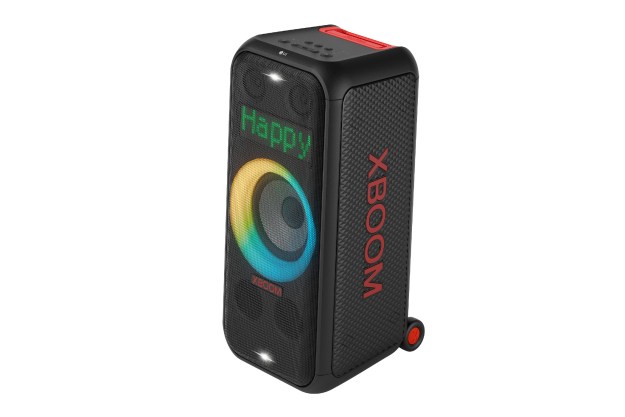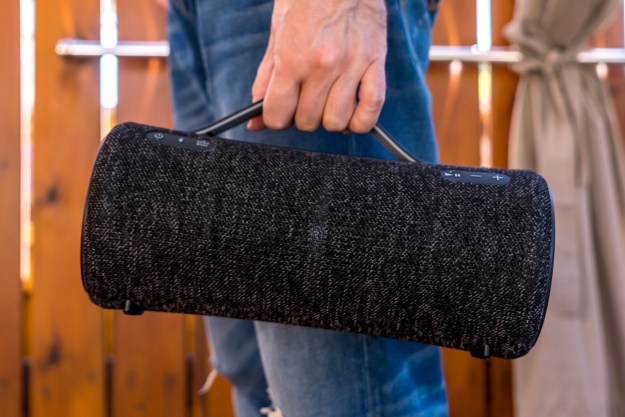
“Big sound, fun extras, in a portable, expandable party speaker.”
- Nice and rugged build
- Great sound quality
- LEDs are cool
- Easy pairing and app support
- Party Connect works well
- Solid battery life
- Only one custom EQ setting allowed
- Phone calls could be better
When you think of the best headphones or wireless earbuds, Sony is usually somewhere at the top of the heap. The company’s portable Bluetooth speakers don’t always come with the same cachet, but the pedigree remains, and the name of the game is to pack big sound into smaller packages.
The $350 SRS-XG300 isn’t a “small” speaker, it’s somewhere in the middle, acting as a more mobile alternative to Sony’s XG500 boombox. But can you really reduce the box, yet keep enough boom to please a party? We decided to find out.
What’s in the box
It’s a sizeable box made of all recyclable material to fit the XG300, along with a power adapter and quick start guide. The cable portion of the adapter is USB-C, and the power adapter provides the extra output necessary to charge this thing faster. You can use another USB-C cable if you have one handy, but unless the wall outlet can do higher wattage, it won’t charge as fast. While the speaker does have a 3.5mm Aux-In port, Sony doesn’t include a cable for it in the box.
Design
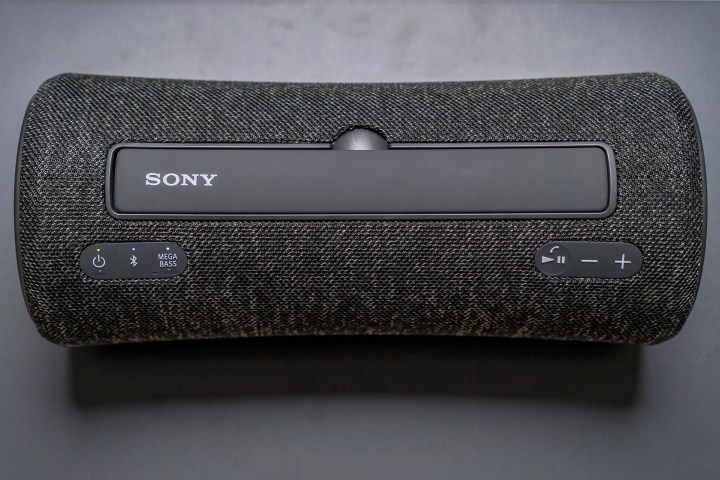
What stands out initially isn’t so much the XG300’s size, it’s the weight. At 6.6 pounds, it’s not what I would call especially light for a Bluetooth speaker you’ll be carrying with you. Even so, if you’ve ever lugged around the larger XG500 at 12.34 pounds, this one should feel feathery by comparison. Not to mention nimbler and easier to transport. With dimensions like 12.52 x 5.43 x 5.35-inches it will fit in a backpack or duffel bag, or you could take it on a flight where it could stand alone as a carry-on personal item.
The rubberized handle at the top has a nifty retracting mechanism to slide it flush with the rest of the speaker when you don’t need it. A nice fabric finish envelops almost the entire speaker. The XG300 sits on two feet below to keep the speaker upright and stop it from rolling over. Controls fall under two separate sections, with the power, Bluetooth, and Mega Bass buttons on one side, and play/pause/call and volume on the other.
Behind a protective flap in the rear is where you’ll find the 3.5mm Aux-In port and a USB-A port to charge other mobile devices, effectively turning the XG300 into a power bank. Along with the USB-C charging port for the speaker itself, you get dedicated buttons for the battery and lights. Press the battery button and a voice chimes in telling you how much juice is left in the tank. Press and hold it and you toggle the Battery Care mode on/off (I’ll get to that feature later). The light button turns the LEDs ringing the two passive radiators on both ends on or off, though you have broader control over that through Sony’s app.
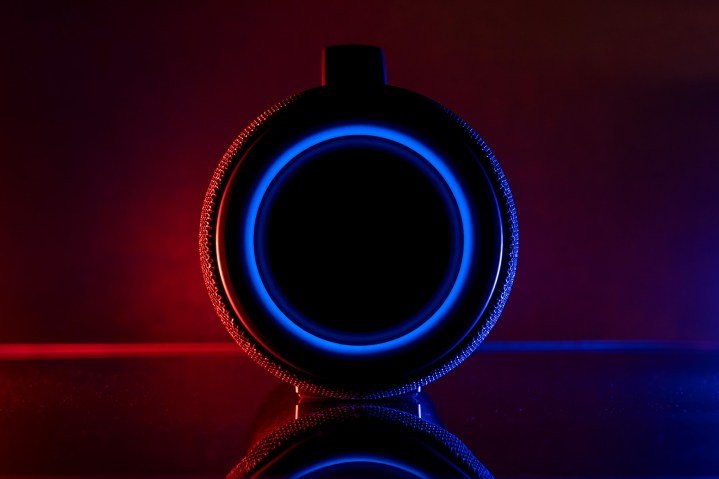
Despite the fabric skin, Sony tried to mold this speaker into a tough player. It sports an IP67 rating, making it more than at home by the pool or the beach. It can withstand splashes and get fully wet, though I would advise against dunking it in salt water, as sand and salt could get lodged into the perforations within the fabric. By all means, take it to the beach and have fun with it, but make sure to rinse it clean with fresh water after. One major point to note is the XG300 lacks the shockproof build Sony’s other two latest Bluetooth speakers, the XE300 and XE200, already offer. Try not to drop this one or roll it over to an untimely demise.
On the inside, Sony plays up its proprietary X-Balanced technology that moves away from traditional circular diaphragms to something more expansive and rectangular. Sony says it increases the sound pressure for thicker bass, better mids, and less distortion at higher volumes. You get two X-Balanced drivers and two traditional tweeters to help with the highs to round out the overall audio experience.
It’s virtually identical to the setup found in the larger XG500, but with smaller, less powerful drivers so the XG300 can’t get as loud. Another difference: Sony added a microphone to the XG300, enabling phone calls and access to voice assistants, something its bigger brother doesn’t have.
Setup and app controls

With Google Fast Pair, Android devices will lock in with the XG300 in no time. Pairing is similarly fast with iOS devices, with only the extra (first) step of pairing in the Bluetooth menu under settings. Sony’s Music Center app is your conduit to select features and controls, though they aren’t abundant. You get shortcuts to music and audio streaming services apps you have installed on your phone, plus access to any audio files you’ve stored locally on your phone.
Under settings, the Sound menu lets you adjust the profile to what you want. By default, Mega Bass is on, though you can also choose to create a custom EQ setting for yourself by moving the bass, middle, and treble sliders to wherever you like. It’s a standalone situation, meaning you can’t save various presets, you must adjust the custom EQ each time you want to make a change.
I suspect part of the reason for this is because Sony is convinced its own ClearAudio+ sound engineering is the way to go. The problem is, you can only listen to it with Mega Bass. It doesn’t apply to the custom EQ or Live Sound modes. That latter mode tries to create more reverb and concave-style effects to emulate concert performances. It’s not bad if you’re at a distance from the speaker, whereas I found it less discernible in closer proximity.
The DJ Effect setting is interesting if you like messing with tracks while they’re playing. It’s hardly a full-on mixer, though you do get isolator and flanger effects. Isolator affects one or more of the lows, mids, or highs, depending on where you go on the slider within the app. Even if you don’t know anything about DJing, you would recognize the effect if you’ve been to a nightclub before. Flanger doubles the sound to create a modulating swooping effect that gets more aggressive as you move up the slider. These effects are really more about timing than anything, and more of a toy to play with while listening to tunes on the XG300.
It’s an awesome mix that left me impressed with the clarity and resonance.
The Illumination section controls the LEDs on the sides, with nine modes to choose from. Some will have a static light, whereas others will shift and change in a pattern or even to the beat of the music. Another app, Fiestable (Android/iOS), can tie into that. It’s free to download, and lets you apply party-like effects to the lights. Again, something worth playing around with to see if you like it for certain situations.
The ability to group speakers together can take things even further. You can stereo pair two XG300s for separate left and right channels, something I wasn’t able to test, unfortunately. Party Connect lets you group together compatible speakers to play music in sync. It’s a pretty seamless process, and it worked for me with the XE300 and XE200 as well. Sony says it will work with any of its speakers that support Party Connect, so there is some utility here. You could spread the speakers out, including placement in different rooms for a quasi-multiroom setup, though the speakers must play the same content, and Bluetooth range will ultimately limit how far apart they can be from one another.
Sound quality
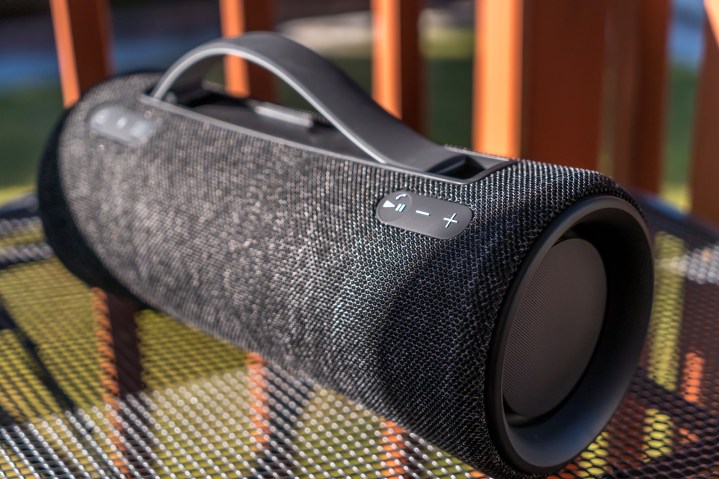
The XG300 supports the SBC, AAC, and Sony’s own LDAC codec for hi-res content. You may not care as much about the codecs if you’re just looking to entertain yourself and others with the boom inside this thing. Sony certainly brought the bass, but I would argue the rest of the audio spectrum stands out, too. Even with Mega Bass off, the sound does skew a little to the lows, though when you leave it on, it’s still an awesome mix that left me impressed with the clarity and resonance.
It’s a level of clarity you simply don’t get with competing products like the Monster Blaster 3.0, which, admittedly, has more oomph on the bass courtesy of its larger size. While Monster isn’t going to beat Sony on fidelity, it was a telling contrast because it may lend some credibility to Sony’s claims that its non-circular diaphragm is doing something different. Mind you, if you just want good sound, you probably won’t care how they do it.
Not that I was all that surprised this speaker would turn out to be a crowd pleaser.
It was equally impressive to see how the clarity and resonance came through at different angles. Every speaker has a sweet spot, typically dead center in front of it, and that is true here as well, only you won’t feel like there’s a big drop-off if you veer away from it. I’m not sure how much that would improve when stereo pairing two XG300s together, but I can imagine it would only get better from there.
There are some nuances to note involving volume. As with all speakers, there are tipping points. With the XG300, the vibrancy and clarity goes up a notch from 50-60% and from 60-70%. These are noticeable changes, and the best way I can describe it is the audio gets a “kick” that brings out the best in what the speaker can do. Push it up to 90% and distortion still doesn’t roar in to ruin things, though I would say the sweetest spots are between 60-80%. At full blast, the sound is fine, though impossible to remove all distortion, which is far easier to hear the closer you are to the speaker.

Not that you have to blast music all the time. I really enjoyed using the XG300 to chill out on a deck listening to jazz or a podcast at a lower volume, carrying it back into the house with me when I wanted to keep listening. Despite the emphasis on bass response, I found all genres sounded great, and others who took a listen with different tastes agreed. Not that I was all that surprised this speaker would turn out to be a crowd pleaser.
I also used the XG300 to watch shows and movies, particularly through the Aux-In port with a small projector. It worked fine, but you may find the overall volume level to be lower when you use it this way. Via Bluetooth on a Pixelbook Go, I noticed a slight lag that didn’t make content unwatchable, but I also didn’t love the audio/video syncing, either. I got similar results with an
I also wasn’t as taken with it for phone calls. It’s nice to have the ability to take a call and chat with someone, except the experience isn’t consistently good. I could hear callers just fine, but the onboard mic doesn’t do an exceptional job picking up voices farther away. I had to sit or stand much closer to it to be audible and ensure callers could make out what I was saying. I tested the effect myself, and it’s akin to how someone sounds when they’re talking through their phone’s speaker from a distance.
Battery life

Sony says the XG300 can play up to 25 hours per charge, but there’s fine print affecting that number. The 25-hour mark is if you’re playing at default volume with Mega Bass on and LED lights off. Because of the variables involved, like if the lights were just static or pulsing, and changes to volume and sound modes, it was hard for me to nail down exact battery life. If I were to approximate, I found the battery lasted for about 17 hours with lights always on, volume at 60-70%, and Mega Bass toggled on throughout. Those numbers aren’t bad, considering the power you get in exchange.
In a pinch, you can plug in for 10 minutes and get up to 70 minutes of playback. You can also go into the app in the settings under Power Option and look at the options there. Stamina mode shuts off the lights and radically reduces the bass response to save power. Battery Care is on by default, suppressing the charging level to 90% to preserve and extend the battery’s lifespan. Auto Standby, also on by default, shuts the speaker down if it’s not doing anything for 15 minutes.
Our Take
It’s so easy to enjoy a speaker that just plays well without requiring a whole lot of tinkering, and I believe that’s a big part of the appeal here. True, it doesn’t come cheap at $350, but it holds up against all comers in that price range, so you are getting your money’s worth. A tad heavy, yet not huge in size, it’s also portable enough to carry around if you are so inclined.
Is there a better alternative?
It’s important to look at the XG300 as a Bluetooth speaker and view comparisons from that vantage point because there are stationary speakers out there that you have to keep plugged in that also sound great. So, with that in mind, the $300 JBL Xtreme 3 is similar in size and concept, except you have to attach a shoulder strap to carry it, as there is no handle. It does weigh less, has the same IP67 protection, and allows for matching up compatible speakers under JBL’s PartyBoost feature. Still, you get less battery life and the speaker won’t match the XG300’s clarity at higher volumes.
The $180 Anker Soundcore Motion Boom Plus is a more affordable boombox offering excellent app support to go with its 80 watts of power. Aesthetically and sonically, it won’t match what Sony’s done, and while a pound lighter, it is bigger and won’t manage the same sound quality and battery life the XG300 can offer.
How long will it last?
Sony made this speaker to last, but it’s up to you to make sure it does. The IP67 protection is great for water and dust resistance, though you will want to rinse it clean if it’s been in contact with sand or dirt. Sony’s one-year warranty doesn’t cover water damage, only functional issues, so be nice to the XG300 to keep it playing for a long time.
Should you buy it?
Yes. If you’re looking for a speaker roughly this size and the price is right, you won’t be disappointed in what your money buys you here. The XG300 is arguably the speaker to beat at its size and weight right now.
Editors' Recommendations
- What is Dolby Vision? The dynamic HDR format fully explained
- How to know if you’re actually getting Dolby Atmos sound
- The best speaker brands of 2023: JBL, Sonos, KEF, and more
- Sonos’ new Era 100 and Era 300 wireless speakers go all-in on spatial audio and Bluetooth
- The best TV brands of 2023: from LG to TCL, which should you buy?







